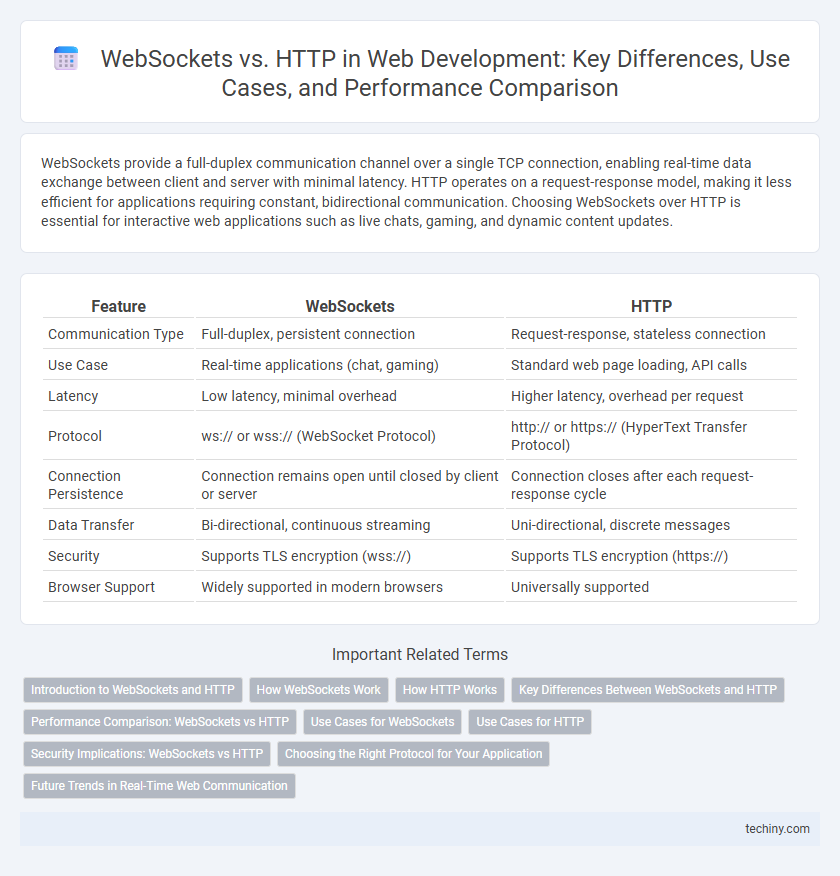WebSockets provide a full-duplex communication channel over a single TCP connection, enabling real-time data exchange between client and server with minimal latency. HTTP operates on a request-response model, making it less efficient for applications requiring constant, bidirectional communication. Choosing WebSockets over HTTP is essential for interactive web applications such as live chats, gaming, and dynamic content updates.
Table of Comparison
| Feature | WebSockets | HTTP |
|---|---|---|
| Communication Type | Full-duplex, persistent connection | Request-response, stateless connection |
| Use Case | Real-time applications (chat, gaming) | Standard web page loading, API calls |
| Latency | Low latency, minimal overhead | Higher latency, overhead per request |
| Protocol | ws:// or wss:// (WebSocket Protocol) | http:// or https:// (HyperText Transfer Protocol) |
| Connection Persistence | Connection remains open until closed by client or server | Connection closes after each request-response cycle |
| Data Transfer | Bi-directional, continuous streaming | Uni-directional, discrete messages |
| Security | Supports TLS encryption (wss://) | Supports TLS encryption (https://) |
| Browser Support | Widely supported in modern browsers | Universally supported |
Introduction to WebSockets and HTTP
WebSockets enable full-duplex communication channels over a single TCP connection, allowing real-time data exchange between clients and servers, which is essential for interactive web applications like chat and gaming. HTTP, a stateless protocol, follows a request-response model where clients initiate requests and servers respond, making it suitable for traditional web page loading but less efficient for continuous, bidirectional communication. Understanding the fundamental differences in how WebSockets maintain persistent connections versus HTTP's short-lived transactions is crucial for optimizing web application performance and user experience.
How WebSockets Work
WebSockets establish a persistent, full-duplex communication channel between a client and server over a single TCP connection, enabling real-time data exchange without repeated HTTP requests. This protocol initiates with an HTTP handshake, then upgrades the connection to WebSocket, allowing low-latency, bidirectional messaging ideal for interactive web applications like gaming, chat, and live updates. Compared to HTTP's request-response model, WebSockets maintain an open connection, reducing overhead and improving performance for continuous data transmission.
How HTTP Works
HTTP operates as a request-response protocol where clients send requests to servers, which then process and return the appropriate resources like HTML, CSS, or JSON. Each HTTP transaction is stateless and independent, requiring a new connection or reopening the session for subsequent requests. This mechanism contrasts with persistent, full-duplex connections in WebSockets, making HTTP less suitable for real-time, bidirectional communication.
Key Differences Between WebSockets and HTTP
WebSockets provide full-duplex communication channels over a single TCP connection, enabling real-time data transfer between client and server, whereas HTTP follows a request-response model with stateless connections. HTTP relies on multiple connections for continuous data exchange, leading to increased latency and overhead compared to persistent, low-latency WebSocket connections. Security protocols such as HTTPS and WSS ensure encrypted communication in both technologies, but WebSockets offer more efficient bidirectional networking suited for live updates and interactive applications.
Performance Comparison: WebSockets vs HTTP
WebSockets provide a full-duplex communication channel over a single TCP connection, significantly reducing the overhead associated with HTTP's request-response model. Unlike HTTP, which requires opening and closing connections for each request, WebSockets maintain persistent connections, resulting in lower latency and faster data transfer rates ideal for real-time applications. Performance benchmarks indicate WebSockets can achieve up to 90% reduction in network traffic and substantially improved throughput compared to traditional HTTP polling methods.
Use Cases for WebSockets
WebSockets excel in real-time applications such as live chat, online gaming, and financial trading platforms where continuous, low-latency communication between client and server is essential. Unlike HTTP's request-response model, WebSockets establish a persistent connection allowing instant data exchange, ideal for collaborative tools and live sports updates. This bidirectional communication enables efficient state synchronization and reduces overhead, making WebSockets a preferred choice for interactive web experiences and streaming data services.
Use Cases for HTTP
HTTP is ideal for stateless, request-response communication where each client request is independent, such as fetching web pages, submitting form data, and RESTful API interactions. It excels in scenarios requiring reliable, cacheable connections and simplified cross-origin resource sharing (CORS) configurations. HTTP's widespread support and compatibility make it optimal for traditional web applications and public APIs with less frequent real-time interaction needs.
Security Implications: WebSockets vs HTTP
WebSockets establish persistent, full-duplex communication channels, creating unique security challenges such as increased attack surfaces for cross-site WebSocket hijacking and data injection compared to stateless HTTP requests. Both protocols rely on TLS encryption (wss:// for WebSockets and https:// for HTTP) to secure data in transit, but WebSocket connections require rigorous origin validation and strict message-level security to prevent unauthorized access and man-in-the-middle attacks. HTTP benefits from mature security mechanisms like secure cookies and comprehensive header controls, whereas WebSocket implementations must integrate additional safeguards like authentication tokens and throttling to mitigate risks inherent in continuous connections.
Choosing the Right Protocol for Your Application
WebSockets provide full-duplex communication channels over a single TCP connection, making them ideal for real-time applications like online gaming, chat apps, and live data feeds. HTTP operates on a request-response model better suited for standard web page delivery and RESTful APIs where real-time interaction is unnecessary. Selecting WebSockets over HTTP significantly improves efficiency and reduces latency for interactive applications requiring continuous data exchange.
Future Trends in Real-Time Web Communication
WebSockets offer persistent, full-duplex communication channels essential for emerging real-time web applications, enabling lower latency compared to traditional HTTP request-response models. Future trends indicate increasing integration of WebSockets with HTTP/2 and HTTP/3 protocols to enhance performance and security in interactive web experiences. Advances in edge computing and 5G deployments will further accelerate the adoption of WebSockets for real-time data streaming, gaming, and collaborative tools.
WebSockets vs HTTP Infographic

 techiny.com
techiny.com